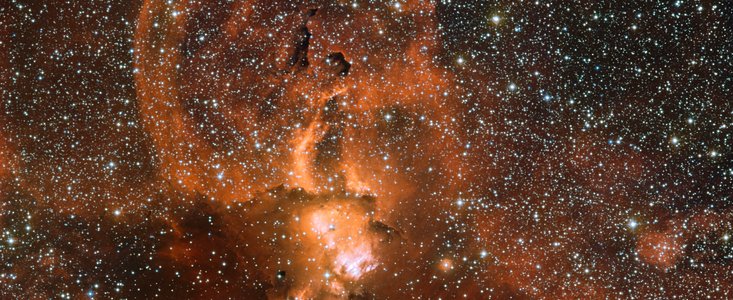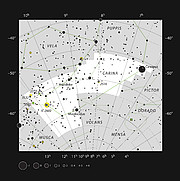Nota de prensa
Fuegos artificiales de una estrella que muere
13 de Abril de 2011
Esta imagen de la nebulosa NGC 3582, que fue tomada con el instrumento Wide Field Imager del telescopio MPG/ESO de 2,2 metros, en el Observatorio La Silla de ESO en Chile, muestra gigantescos arcos de gas asombrosamente similares a las prominencias solares. Se piensa que estos arcos son eyectados por estrellas que mueren, sin embargo también hay nuevas estrellas que nacen en esta maternidad estelar. Estas estrellas jóvenes y energéticas emiten una intensa radiación ultravioleta que hace brillar el gas dentro de la nebulosa, dando la impresión de fuegos artificiales.
NGC 3582 es parte de la gran región de formación estelar de la Vía Láctea llamada RCW 57. Se encuentra cerca del plano central de la Vía Láctea, en la constelación austral de Carina. John Herschel fue el primero en observar esta región de gas incandescente y nubes oscuras de polvo en 1834, durante su estadía en Sudáfrica.
Algunas de las estrella en formación en regiones como NGC 3582 son mucho más masivas que el Sol. Estas monstruosas estrellas emiten energía a velocidades prodigiosas y poseen vidas muy cortas que terminan en explosiones llamadas supernovas. El material eyectado en estos dramáticos eventos crea burbujas en el gas y polvo circundantes. Probablemente ésta sea la causa de los arcos visibles en esta imagen.
Esta fotografía fue tomada a través de múltiples filtros con el instrumento Wide Field Imager del telescopio MPG/ESO de 2,2 metros en el Observatorio La Silla de ESO, en la Región de Coquimbo en Chile. Los datos tomados a través del filtro rojo están representados con los colores verde y rojo, y los datos tomados a través de un filtro que aísla el característico brillo rojo del hidrógeno también son representados con el color rojo. Datos adicionales obtenidos por el Digitized Sky Survey son representados con el color azul.
La imagen fue procesada por ESO usando datos de archivo identificados por Joe DePasquale, de Estados Unidos [1], quien participó en el concurso de astrofotografía de ESO Tesoros Escondidos 2010 [2]. El concurso, organizado por ESO en Octubre-Noviembre de 2010, estuvo dirigido a todos quienes disfrutan creando bellas imágenes del cielo nocturno a partir de datos astronómicos obtenidos a través de telescopios profesionales.
Notas
[1] Joe buscó en el archivo de ESO e identificó grupos de datos que finalmente utilizó para componer su imagen de NGC 3582, la que obtuvo el décimo lugar en el concurso de un total de casi 100 postulaciones. Su trabajo original está disponible aquí.
[2] El concurso Tesoros Escondidos de ESO 2010 dio a los astrónomos aficionados una oportunidad de revisar los vastos archivos de información astronómica de ESO en busca de alguna joya cósmica bien guardada que necesitaba ser pulida por los participantes. Si quieres saber más sobre el concurso Tesoros Escondidos, visita el sitio web en inglés http://www.eso.org/public/outreach/hiddentreasures/.
Información adicional
ESO, el Observatorio Europeo Austral, es la principal organización astronómica intergubernamental en Europa y el observatorio astronómico más productivo del mundo. Es apoyado por 15 países: Alemania, Austria, Bélgica, Brasil, Dinamarca, España, Finlandia, Francia, Holanda, Italia, Portugal, el Reino Unido, República Checa, Suecia y Suiza. ESO desarrolla un ambicioso programa enfocado en el diseño, construcción y operación de poderosas instalaciones de observación terrestres que permiten a los astrónomos hacer importantes descubrimientos científicos. ESO también cumple un rol principal en promover y organizar la cooperación en investigación astronómica. ESO opera tres sitios únicos de observación de clase mundial en Chile: La Silla, Paranal y Chajnantor. En Paranal, ESO opera el Very Large Telescope, el observatorio óptico más avanzado del mundo. ESO es el socio europeo de un revolucionario telescopio, ALMA, el proyecto astronómico más grande en desarrollo. ESO está actualmente planificando el European Extremely Large Telescope, E-ELT, el telescopio óptico y de infrarrojo cercano de 42 metros de diámetro, que llegará a ser “el ojo más grande del mundo en el cielo”.
Enlaces
Contactos
Richard Hook
ESO, La Silla, Paranal, E-ELT and Survey Telescopes Public Information Officer
Garching bei München, Germany
Teléfono: +49 89 3200 6655
Celular: +49 151 1537 3591
Correo electrónico: rhook@eso.org
Francisco Rodríguez (Contacto para medios de comunicación en Chile)
Red de Difusión Científica de ESO
y European Southern Observatory
Teléfono: +56-2-463-3151
Correo electrónico: eson-chile@eso.org
Acerca de la nota de prensa
| Nota de prensa No.: | eso1113es-cl |
| Nombre: | NGC 3582 |
| Tipo: | Milky Way : Nebula : Type : Star Formation |
| Facility: | MPG/ESO 2.2-metre telescope |
| Instruments: | WFI |
Our use of Cookies
We use cookies that are essential for accessing our websites and using our services. We also use cookies to analyse, measure and improve our websites’ performance, to enable content sharing via social media and to display media content hosted on third-party platforms.
ESO Cookies Policy
The European Organisation for Astronomical Research in the Southern Hemisphere (ESO) is the pre-eminent intergovernmental science and technology organisation in astronomy. It carries out an ambitious programme focused on the design, construction and operation of powerful ground-based observing facilities for astronomy.
This Cookies Policy is intended to provide clarity by outlining the cookies used on the ESO public websites, their functions, the options you have for controlling them, and the ways you can contact us for additional details.
What are cookies?
Cookies are small pieces of data stored on your device by websites you visit. They serve various purposes, such as remembering login credentials and preferences and enhance your browsing experience.
Categories of cookies we use
Essential cookies (always active): These cookies are strictly necessary for the proper functioning of our website. Without these cookies, the website cannot operate correctly, and certain services, such as logging in or accessing secure areas, may not be available; because they are essential for the website’s operation, they cannot be disabled.
Functional Cookies: These cookies enhance your browsing experience by enabling additional features and personalization, such as remembering your preferences and settings. While not strictly necessary for the website to function, they improve usability and convenience; these cookies are only placed if you provide your consent.
Analytics cookies: These cookies collect information about how visitors interact with our website, such as which pages are visited most often and how users navigate the site. This data helps us improve website performance, optimize content, and enhance the user experience; these cookies are only placed if you provide your consent. We use the following analytics cookies.
Matomo Cookies:
This website uses Matomo (formerly Piwik), an open source software which enables the statistical analysis of website visits. Matomo uses cookies (text files) which are saved on your computer and which allow us to analyze how you use our website. The website user information generated by the cookies will only be saved on the servers of our IT Department. We use this information to analyze www.eso.org visits and to prepare reports on website activities. These data will not be disclosed to third parties.
On behalf of ESO, Matomo will use this information for the purpose of evaluating your use of the website, compiling reports on website activity and providing other services relating to website activity and internet usage.
Matomo cookies settings:
Additional Third-party cookies on ESO websites: some of our pages display content from external providers, e.g. YouTube.
Such third-party services are outside of ESO control and may, at any time, change their terms of service, use of cookies, etc.
YouTube: Some videos on the ESO website are embedded from ESO’s official YouTube channel. We have enabled YouTube’s privacy-enhanced mode, meaning that no cookies are set unless the user actively clicks on the video to play it. Additionally, in this mode, YouTube does not store any personally identifiable cookie data for embedded video playbacks. For more details, please refer to YouTube’s embedding videos information page.
Cookies can also be classified based on the following elements.
Regarding the domain, there are:
- First-party cookies, set by the website you are currently visiting. They are stored by the same domain that you are browsing and are used to enhance your experience on that site;
- Third-party cookies, set by a domain other than the one you are currently visiting.
As for their duration, cookies can be:
- Browser-session cookies, which are deleted when the user closes the browser;
- Stored cookies, which stay on the user's device for a predetermined period of time.
How to manage cookies
Cookie settings: You can modify your cookie choices for the ESO webpages at any time by clicking on the link Cookie settings at the bottom of any page.
In your browser: If you wish to delete cookies or instruct your browser to delete or block cookies by default, please visit the help pages of your browser:
Please be aware that if you delete or decline cookies, certain functionalities of our website may be not be available and your browsing experience may be affected.
You can set most browsers to prevent any cookies being placed on your device, but you may then have to manually adjust some preferences every time you visit a site/page. And some services and functionalities may not work properly at all (e.g. profile logging-in, shop check out).
Updates to the ESO Cookies Policy
The ESO Cookies Policy may be subject to future updates, which will be made available on this page.
Additional information
For any queries related to cookies, please contact: pdprATesoDOTorg.
As ESO public webpages are managed by our Department of Communication, your questions will be dealt with the support of the said Department.





